Minnesota Scientific and Natural Area
NATURE NOTES
|
|
|
Fall 2018
Railroads and Conservation: A Series of Fortunate Events
By Paula J Comeau, Northwest Region SNA Naturalist
The Bluestem Prairie Scientific and Natural Area (SNA) is a unique landscape nestled amongst the beach ridges of glacial Lake Agassiz in Clay County, Minnesota. It is listed as one of the regions birding “hotspots” along with its counterpart Buffalo River State Park, and Felton Prairie SNA that lies just to the north off Highway 9. It is also a favorite location for wildflower photographers and hikers. Bluestem Prairie SNA is here today thanks to a series of fortunate events.
LUCK OF THE LAND
The sand and gravel soils of this prairie resulted in the land being used primarily for grazing, and for this reason untouched by the plow. This was just one of the many fortunate events in Bluestem’s history. The landscape remains a relatively pristine example of what the Red River Valley looked like for hundreds of years prior to European settlement.
THE RAILROAD AND EARLY CONSERVATION
The late 19th and early 20th centuries were a time of development and conservation for the Red River Valley. A major project was the development of a railroad through Clay Country. Created in 1872, to support a chain of small towns, the railroad was expanded in 1906 and would help turn the Red River Valley into a modern regional route an hub.
When Buffalo River State Park was founded in 1936 the railroad provided a vital means of transportation to and from the area. The development of the state park set in motion a culture of conservation in the area, and this momentum continued into 1960’s when the park was expanded.
In 1975, The Nature Conservancy entered the picture and acquired 1,000 acres south of Buffalo River State Park and continued to grow their Bluestem Prairie Preserve to its current 6,078 acres. In 1982, Bluestem Prairie Scientific and Natural Area was designated within the Preserve and State Park to enhance prairie protection.
A LOVE FOR THE LAND
This multi-organizational effort to protect the prairie also grabbed the attention of a local unsung ecological hero. In 1909 A.O. Stevens accepted a position at North Dakota Agriculture College (NDAC), now known as North Dakota State University (NDSU). Stevens was a motivated young botanist drawn from Kansas to North Dakota by the new State Seed Laboratory in Fargo.
Stevens was a fortunate addition to Bluestem Prairies’ history. Beginning in the spring of 1910, Stevens monitored the prairie. According to Dr. Jack Norland, Associate Professor of Natural Resources Management at NDSU, the railroad allowed Stevens to explore the prairie and what is now Buffalo River State Park. During Stevens 67 years at NDSU, he collected an average of 800 plant samples a summer and over 12,000 bee and wasps specimens over his career. For fifty years, he recorded the dates of species in bloom. His work makes up one of the largest datasets in the Northern Great Plains, and have given researchers a tool to evaluate the impacts of climate change on Bluestem Prairie.
For the Great Plains, the impact of Stevens work is comparable to Henry Thoreau and Aldo Leopold, and just as Thoreau had his Walden and Leopold his “Shack”, so Stevens had his Bluestem.
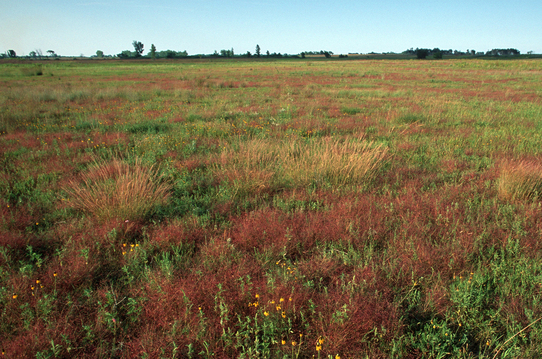
Bluestem Prairie Scientific and Natural Area. Photo by ColdSnap Photography
THE PRESENT PRAIRIE
Thanks to the accessibility to the railroad, the protection provided by multiple organizations, and O.A. Stevens devoted monitoring, Bluestem Prairie is an extensive, high quality, and well researched remnant of native grassland. Bluestem Prairies' uplands contain mesic tallgrass prairie, while low swales contain wet black-soil prairie with sedge meadow and calcareous fen communities. Rare plants found on Bluestem Prairie include the sticky false asphodel, alkali and slender cordgrass, small white lady’s slipper, and a rare sedge. Rare wildlife includes the regal fritillary butterfly, prairie vole, plains pocket mouse, northern grasshopper mouse, Wilson’s Phalarope, Henslow's Sparrow, Marbled Godwit, Loggerhead Shrike, and Greater Prairie-Chicken.
Through a series of fortunate events, the Red River Valley has become a piece of living history. The diversity of this native prairie continues to impress, just as it did when the early settlers first arrived and Native American communities dominated the Great Plains. Today, birders, hiker, citizen scientists, and researchers all visit Bluestem Prairie to appreciate its beauty and understand its history. It stands as a reminder that sometimes the most amazing things can arise from a series of seemly unrelated, but fortunate, events.
Today, Bluestem Prairie is a joint effort to conserve prairie in the Red River Valley. The 1310 acre Bluestem Prairie Scientific and Natural Area is within the 1200 acre Buffalo River State Park and the 4,658 acre Nature Conservancy Preserve. It is also neighbored by 400 acres owned by Minnesota State University Moorhead, forming one of the largest protected areas of prairie in the country.
|
|
Natural Areas Offer Fall Color Off the Beaten Path
Fall is finally here and that means it is the perfect time to get outside! Explore Scientific and Natural Areas across the state to see some stunning fall colors.
Northern Minnesota Peatlands, Prairie-Forest Transition, and Aspen Parklands
Peak color mid-September to early October
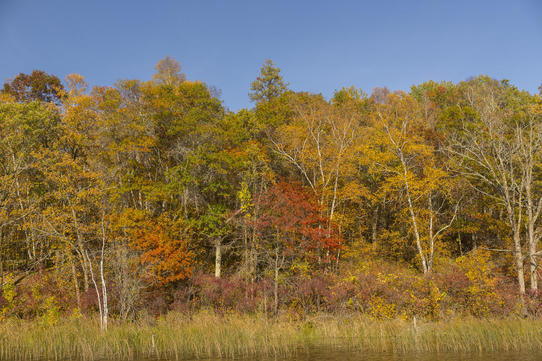
Greenwater Lake Scientific and Natural Area. Photo by ColdSnap Photogrpahy
- Highlight: Colorful native prairie grasses
- Location: Clay County
- Trees aren’t the only thing turning colors in the fall! Prairies also go through beautiful transformations as grasses and sedges turn shades of yellow, orange, brown, purple, and red. Explore Blanket Flower Prairie SNA this fall to see for yourself.
Greenwater Lake SNA
- Highlights: Greenwater Lake, North Country National Scenic Trail
- Location: Becker County
- At 815 acres, Greenwater Lake SNA is one of the larger SNAs in north central Minnesota. This area has varying landscapes including oak-aspen-red maple forest, sugar maple-basswood forest and jack pine woodland. To view the seasonal changes this year, take a stroll along the North Country National Scenic Trail to see the fall colors - along with views the lake.
Gully Fen SNA
- Highlights: Tamarack trees (Larix laricina)
- Location: Polk County
- You can’t miss viewing Minnesota’s only deciduous conifer, the tamarack tree (Larix laricina) this fall! As the weather cools, this tree turns a stunning golden yellow that stands out in the wetland habitat tamaracks prefer. Conditions here range from wet to more wet, so make sure to pack your rubber boots or take in the views from the road!
Itasca Wilderness Sanctuary SNA
- Highlight: Diverse forest (old-growth), hiking trails, Itasca State Park
- Location: Itasca State Park in Clearwater County
- This stunning 1600 acre SNA is fabulous in fall when trees are turning bright red, orange and yellow. Take a walk along the Bohall Wilderness Trail or the Big Red Pine Trail; both are accessible trails that begin from Wilderness Drive in Itasca State Park. You will not be disappointed with the beauty that comes with an undisturbed, diverse forest!
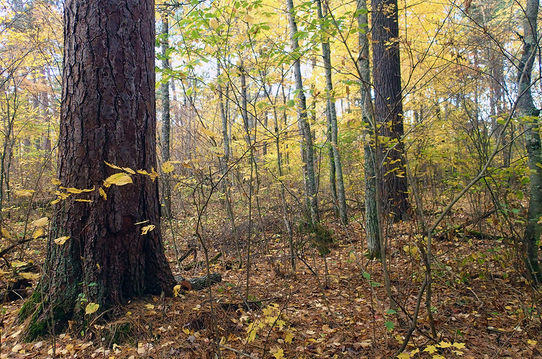
Lost 40 Scientific and Natural Area. Photo by AmberBeth VanNingen
Northern Minnesota Mixed Forests, Boundary Waters, and North Shore
Peak color mid-September to early October
Iona’s Beach SNA
- Highlights: Lake Superior, Gitchi Gami State Trail
- Location: North Shore, Lake County
- Iona’s Beach SNA protects one of the largest and least disturbed Lake Superior beaches in Lake County. Visit this fall for a beautiful view of Lake Superior, a colorful beach made up of pink rhyolite rocks, and a shoreline bordered by aspen and birch that will be bright yellow this fall! Hike along the Gitchi Gami State Trail after walking the beach to find even more color.
Lost 40 SNA
- Highlights: Interpretive trail, old-growth pine mixed with aspen and birch
- Location: Within the Chippewa National Forest and Big Fork State Forest in Itasca County
- Named for a surveying error in 1882, this old-grow white pine-red pine forest is one of a few stands that survived the logging era. Walk the interpretive trail. Enjoy the bright colors of aspens and birches with pine trees over 240 years old. Lost 40 SNA is a perfect place to visit to see autumn in all its glory.
Lutsen SNA
- Highlights: Stunning fall color, vistas, rugged hiking trail
- Location: Cook County
- Enjoy a trip along the North Shore of Lake Superior to this SNA to enjoy all the beauty without the crowds. Lutsen SNA is home to one of the largest areas of essentially undisturbed old-growth northern hardwood forest in Minnesota. Hiking off trail and up to the ridges will make for a breathtaking fall color views.
Mille Lacs Moraine SNA
- Highlights: Sugar maples, migrating songbirds, Sunfish Lake
- Location: West of Mille Lacs Lake in Crow Wing County
- Visit Mille Lacs Moraine to see a complete palette of Minnesota fall colors. See the red of red oaks, the iconic yellow/orange of sugar maples, the green and yellow of the basswoods and the blue of Sunfish Lake!
Watrous Island SNA
- Highlights: Rainy River, Canada!
- Location: Koochiching County
- Accessible by boat only, Watrous Island SNA is actually two adjacent islands that sit along the Canadian border on the Rainy River. Will you be fishing on the river? This SNA makes for a quiet detour. Cast along the shores and enjoy the beautiful views of the black ash – silver maple terrace forest.
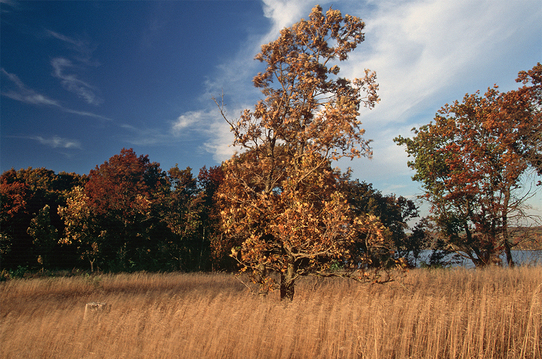
St. Croix Savanna Scientific and Natural Area. Photo by ColdSnap Photography
Central-Southeast Minnesota Big Woods, Hardwood Hills, and Prairies
Peak color late September to early October
Grey Cloud Dunes SNA
- Highlights: Fall prairie colors, Mississippi River
- Location: In Inver Grove Heights, Washington County
- Grey Cloud Dunes has a little bit of everything. Enjoy the colorful dry sand prairie that will be turning yellow, red, purple, and brown as grasses change color. Get your fall foliage fix from the floodplain forest of elm, silver maple, cottonwood and box elder or in the savanna of red and brown oaks. Take it all in while also admiring the sandy dunes and sparkling blue of the Mississippi River.
King’s and Queen’s Bluffs SNA
- Highlights: Fall color vistas, Mississippi River views
- Location: Near Winona in Winona County
- King’s and Queen’s Bluffs SNA preserves two beautiful bluffs that rise more than 600 feet above the Mississippi River. Although Queen’s Bluff is only accessible by permit, you can still enjoy both bluffs by hiking the interpretive trail in Great River Bluffs State Park. This hike will take you to the overlook on King’s Bluff where you’ll see a stunning a view of Queen’s Bluff, the Mississippi River valley, and a mosaic of fall colors.
St. Croix Savanna SNA
- Highlight: St. Croix National Scenic Riverway, oak savanna
- Location: In Bayport, Washington County
- St. Croix Savanna SNA has slopes of dry prairie, terraces of oak savanna and woodlands that make this site an astonishing place in fall. Enjoy the golden grasses and sedges along with the bright reds and oranges of the oaks. Top it all off with a beautiful view of the St. Croix National Scenic Riverway, visible from the bluff top.
Wolsfeld Woods SNA
- Highlights: Trail network, Wolsfeld Lake, Big Woods forest
- Location: In Long Lake, Hennepin County
- This SNA preserves one of the best remaining examples of Big Woods forest communities in Minnesota. Predominately mature maple-basswood forest, this SNA will be bursting with colors this fall. Enjoy the beauty exploring on one of the hiking trails, or join the Friends of Wolsfeld Woods at one of their upcoming events.
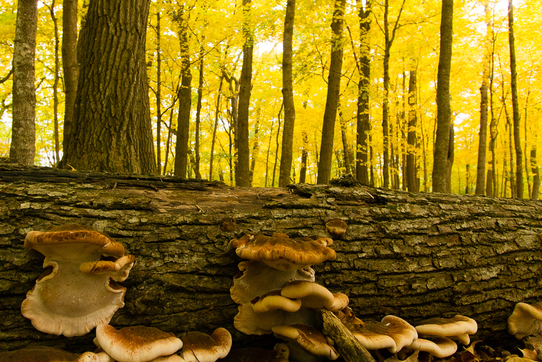
Townsend Woods Scientific and Natural Area. Photo by Dale Bohlke
Southern Minnesota Prairies and River Woodlands
Peak color late September to mid-October
Bonanza Prairie SNA
- Highlights: Far-reaching views, prairie landscape, Big Stone Lake, Big Stone Lake State Park
- Location: In Big Stone Lake State Park, Big Stone County
- Go up the hill from the Education Center at Big Stone Lake State Park to reach this SNA. Soak in a stunning panoramic view of the South Dakota prairie landscape across the waters of Big Stone Lake. This site preserves undisturbed, glacial till hill prairie that will turn all shades of fall color late September into October.
Cedar Mountain SNA
- Highlights: Rock outcrops, Minnesota River
- Location: In the Minnesota River Valley of Redwood Country
- Thanks to cooling magma billions of years ago followed by the work of glaciers, Cedar Mountain SNA is home to some interesting rock outcrops. Visit the woodlands here for the bright yellow, red, and brown fall colors. Enjoy bur oak, ash, and elm that will stand out among the distinctive rocks described from this location (Cedar Mountain Gabbro and Cedar Mountain Granodiorite) estimated to originate over 306 billion years ago.
Townsend Woods SNA
- Highlights: Sugar maples, Big Woods forest
- Location: Near Sakatah Lake State Park in Rice County
- This SNA preserves a high quality remnant of Big Woods sugar maple forest, a native plant community ranked as imperiled in Minnesota. This area not only supports young sugar maples in the understory and canopy, but large red oaks as well. Add in some basswood, elm and ironwood that also grow here, and the half-mile long trek into this SNA will be well worth it to see all the yellows, oranges and reds of fall. Need more fall goodness? Head over to nearby Sakatah Lake State Park for inspiration.
Yellow Banks Hills SNA
- Highlights: Prairie grasses, rolling hills
- Location: Lac Qui Parle County
- Enjoy the far-reaching views of this SNA as grasses turn reds, yellows, browns and purples that can compete with any fall foliage you might find in northern Minnesota! This 78-acre site preserves remnant dry sand-gravel prairie typical of the Great Plains, and provides habitat for several rare plant species. The hills here formed from glacial deposits known as kames.
Want see where these SNAs are located in Minnesota? Take a look at this story map and see what is close to you!
Site Highlight: Malmberg Prairie SNA
By Kelly Randall, SNA Outreach Coordinator
Close your eyes and think of what your senses tell you when you hear the word “prairie”. Did you feel the warmth of a sunny summer day? Did you hear songbirds twittering and wind blowing in the tall grasses? Could you smell the subtle scent of the earth? A walk onto Malmberg Prairie Scientific and Natural Area can be a treat for all of your senses. In the far western reaches of northwestern Minnesota’s Polk County, this natural area is a remnant of the historical landscape of Red River Valley tallgrass prairie.
Never plowed, this 80-acre tract was only used in the past as a hayfield. Today it is one of very few remaining parcels of rich black-soil prairies in the nearly flat basin of Glacial Lake Agassiz. The surrounding fields of corn, soybeans, grains and sugar beets are testament to the great changes that have taken place to this landscape in last century-and-a-half. These fertile soils have become the foundation of American agriculture.
This prairie has much to offer for those willing to look closely and wait patiently. See a profusion wildflowers, grasses, and sedges from spring through fall. Minnesota Biological Survey ecologist Fred Harris recommends a visit in August for a sensational variety of native flora. A good variety of birds await the wildlife viewing enthusiast, including a few of the more uncommon species such as Nelson's Sparrow , Short-eared Owl, and Yellow Rail.
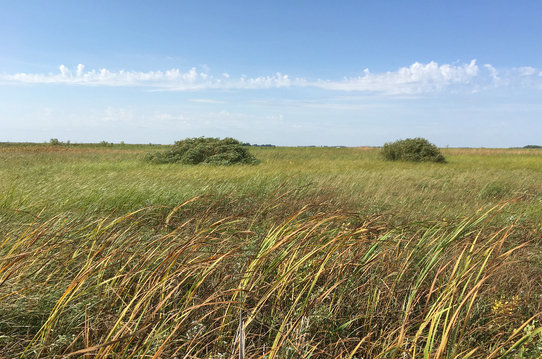
Malmberg Prairie Scientific and Natural Area. Photo by Kelly Randall
SNA Events
Days are growing shorter, temperatures are cooling, and leaves are changing color; it is a perfect time of year to get out and visit an SNA. Why not join us for one these fun events? A full list of events is available on the SNA Events Calendar.
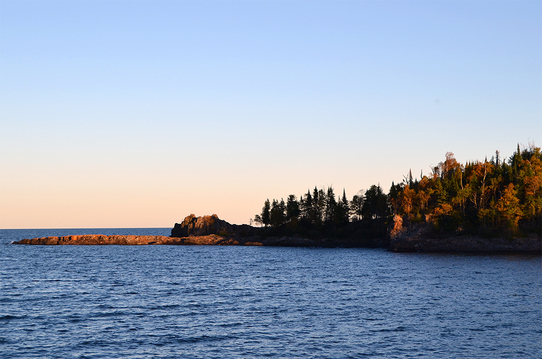
Learn all about Sugarloaf Cove and Sugarloaf Point SNA at the October 20th Open House. Photo by Kristi Loobeek
Notes from Site Stewards
Site stewards monitor SNAs across Minnesota. Their observations provide valuable information to the SNA Program. Here are some interesting notes from recent reports:
- In July, Professor Jack Norland, site steward at Blanket Flower Prairie SNA, visited to survey bee blocks. He noted that “as usual some holes were used and some not”. While walking through the prairie he also identified what he believed to be about a dozen regal fritillary butterflies.
- “It is so pretty walking through here. The trees are in full green.” writes site steward Kyle McIlwain of Botany Bog SNA in mid-August. He also noted that the area had been experiencing smoke from western wildfires for about two weeks.
- One of the Programs newest site stewards, Ryan Flemke visited Oronoco Prairie SNA in early September to clear about half an acre of sumac near the entrance to the site.
- Many site stewards have been working on controlling invasive species on sites across the state. Site steward Paul Hoverstein visited Glynn Prairie SNA in early July to monitor and treat crown vetch. Since then he has reported that control appears to be working and that he will continue to monitor the treated area.
Thanks for all the work you do for SNAs stewards!
|
|
|
Nature Notes is the Minnesota Scientific and Natural Areas quarterly newsletter (archive online). It seeks to increase interest, understanding and support of natural areas while promoting involvement in the protection of these special places. Contact us directly at sna.dnr@state.mn.us.
Funding for this project was provided by the Minnesota Environment and Natural Resources Trust Fund as recommended by the Legislative-Citizen Commission on Minnesota Resources (LCCMR).
|
|
|
|